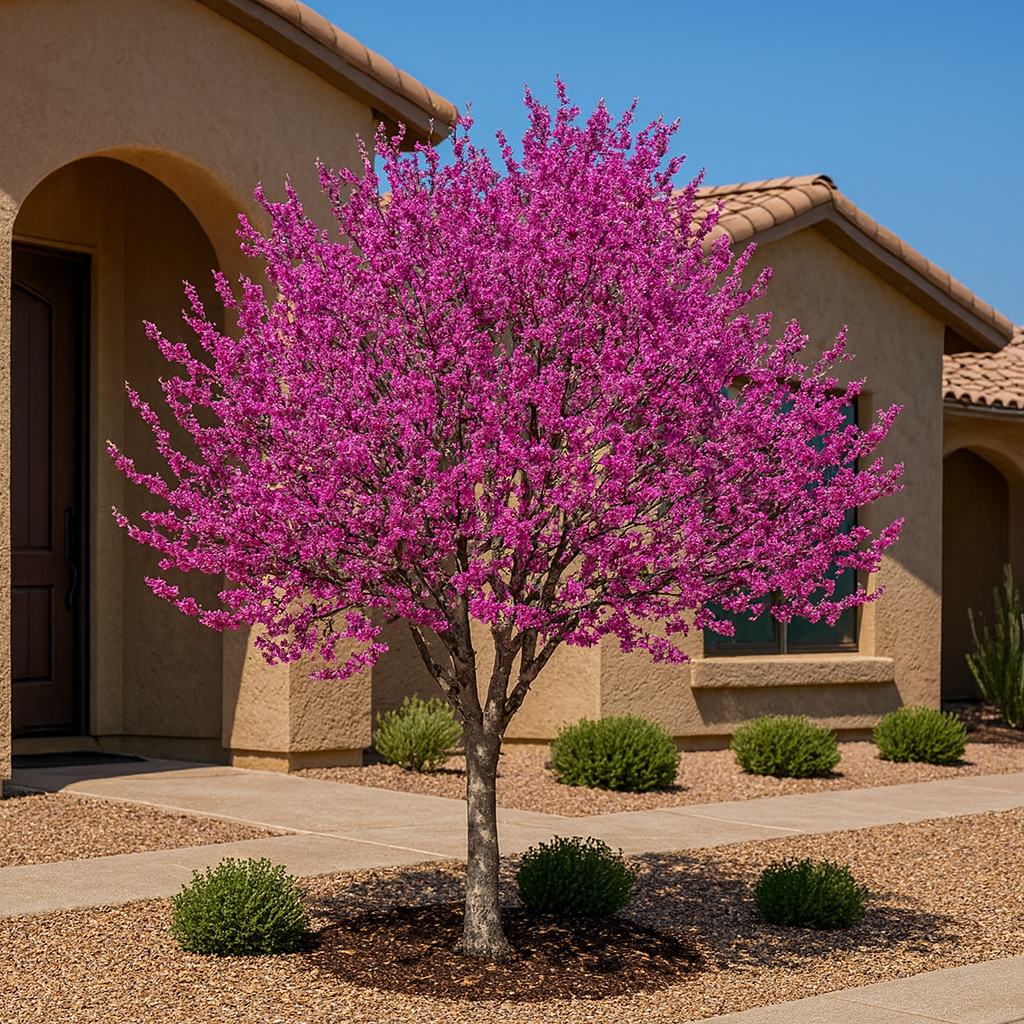My Store
Texas Redbud
Texas Redbud
Couldn't load pickup availability
Plant Type: Deciduous Flowering Tree
Plant Height: 12-20 feet
Spread: 12-15 feet
Flower Color: Rosy-pink to magenta blooms
Sun Exposure: Full sun, Partial shade
Texas Redbud: Glossy Foliage and Showy Spring Blooms
The Texas Redbud (Cercis canadensis var. texensis) is a drought-tolerant variety of the redbud family, well-adapted to hot, dry climates like Arizona. In early spring, before leaves appear, branches burst into clusters of rosy-pink to magenta flowers that create a spectacular display. Its glossy, leathery, heart-shaped leaves are thicker than those of the Eastern Redbud, helping it withstand heat and drought. Compact, resilient, and ornamental year-round, the Texas Redbud is an excellent choice for courtyards, patios, and small landscapes.
Key Features of Texas Redbud
- Brilliant Spring Display: Vivid magenta-pink flowers cover branches before leaf-out in spring.
- Glossy, Heat-Tolerant Leaves: Thick, shiny foliage offers improved drought and heat resistance.
- Compact Size: Ideal for smaller yards, courtyards, and patios.
- Wildlife Value: Flowers attract pollinators, while seeds provide food for birds and wildlife.
Growing and Care Tips
- Soil: Prefers well-drained soil; amend with compost for best results.
- Water: Moderate during establishment; low to moderate once mature.
- Pruning: Minimal pruning required; shape lightly in winter if needed.
- Cold Tolerance: Hardy to about 15°F; dependable across Phoenix Valley landscapes.
Landscaping Uses
- Specimen Tree: A show-stopping focal point in spring.
- Patio Accent: Provides filtered shade and seasonal beauty.
- Mixed Gardens: Combines well with desert-adapted shrubs and flowering perennials.
- Wildlife Gardens: Supports pollinators and birds.
Summary
The Texas Redbud combines spectacular spring blooms with glossy, heat-tolerant foliage, making it a standout ornamental for Arizona landscapes. Smaller and tougher than the Eastern Redbud, it delivers reliable beauty in challenging desert climates.
Three Timbers Installation Guide (Feel Free to Follow):
Texas Redbud Planting Guide
Location: Full sun to partial shade; benefits from afternoon shade in hotter microclimates.
Soil: Well-drained soil; amend with compost for fertility.
Spacing: Plant 12-15 feet apart to allow full canopy spread.
Planting Depth: Place root ball level with surrounding soil; firm lightly.
Support: Stake young trees for the first year until roots establish.
Watering Guide
Watering After Planting:
- Initial Watering: Deeply water immediately after planting.
- Frequency: Every 2-3 days for the first 2 weeks, then weekly for 2-3 months.
- Amount: Provide 5-7 gallons per watering for young trees.
When is the Plant Established?
- Timeframe: Typically 6-9 months in Arizona’s climate.
Watering Once Established:
- Summer: Deep water every 10-14 days; increase to weekly in extreme heat.
- Winter: Water every 4-6 weeks if rainfall is absent.
Drip Irrigation Setup:
- Placement of Emitters: 12-18 inches from trunk, expanding outward as tree grows.
- Flow Rate: 2-4 gallons per hour emitters recommended.
- Number of Emitters: 2-3 per tree, increasing with maturity.
- Adjusting Frequency: Increase watering during bloom season and hottest months; reduce in winter.
General Watering Tips for Texas Redbud
- Soil Check: Water when soil is dry 3-4 inches deep.
- Encourage Flowering: Deep watering in late winter promotes heavier blooming in spring.
- Heat Management: Afternoon shade or protection in very hot areas enhances performance.
- Mulch: Apply organic mulch (2-3 inches) to conserve soil moisture and regulate root temperature, but keep away from trunk.
Share












